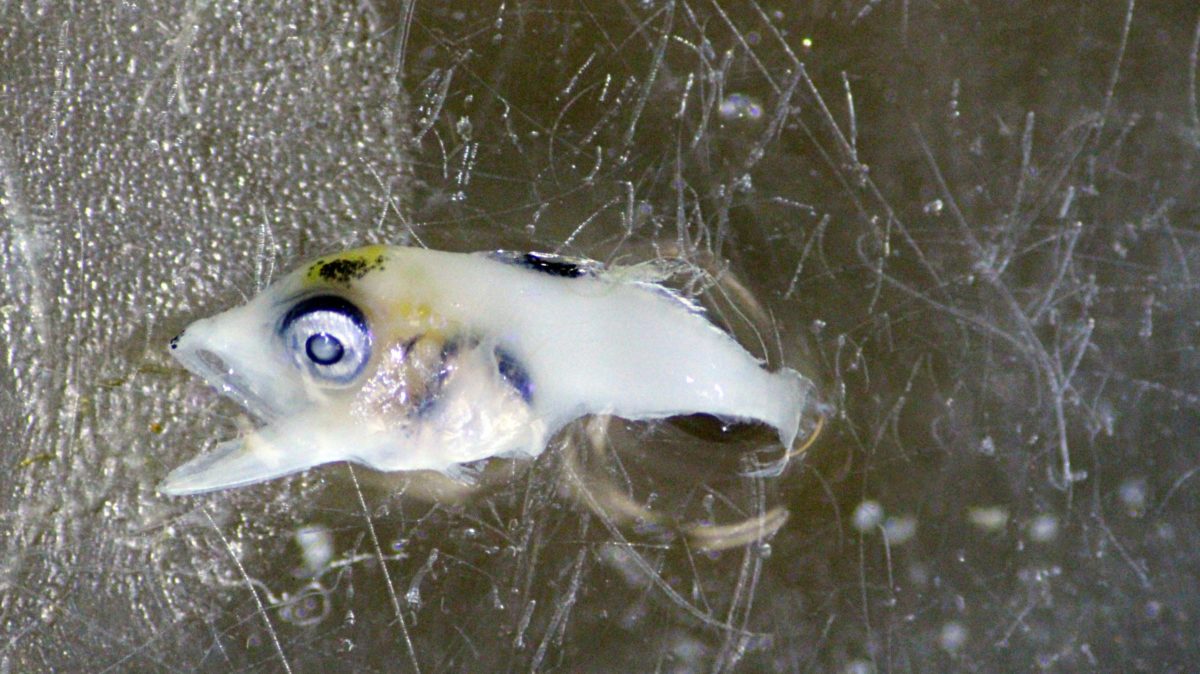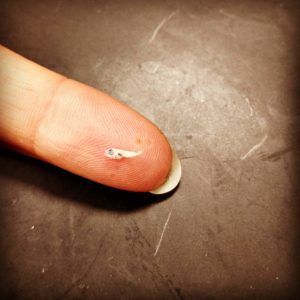Evidence Bolsters Classification of a Major Spawning Ground for Atlantic Bluefin Tuna Off the Northeast U.S.
 Bluefin tuna are the largest of all tuna species – adults can reach ten feet in length and weigh more than a thousand pounds. But they start out small, as 2- to 3-millimeter-long larvae. This one was caught by Chrissy Hernandez in the Slope Sea, a region of the Atlantic Ocean between the between the U.S. continental shelf and the Gulf Stream farther offshore. The area is a newly-recognized spawning ground for western Atlantic bluefin tuna – more good news for a species whose population in the Gulf of Mexico is sustainably managed with a limited harvest. Photo by Chrissy Hernandez © Woods Hole Oceanographic Institution
Bluefin tuna are the largest of all tuna species – adults can reach ten feet in length and weigh more than a thousand pounds. But they start out small, as 2- to 3-millimeter-long larvae. This one was caught by Chrissy Hernandez in the Slope Sea, a region of the Atlantic Ocean between the between the U.S. continental shelf and the Gulf Stream farther offshore. The area is a newly-recognized spawning ground for western Atlantic bluefin tuna – more good news for a species whose population in the Gulf of Mexico is sustainably managed with a limited harvest. Photo by Chrissy Hernandez © Woods Hole Oceanographic Institution March 3, 2022
Woods Hole, MA — The Slope Sea off the Northeast United States is a major spawning ground for Atlantic bluefin tuna (Thunnus thynnus), a new paper affirms. This finding likely has important implications for population dynamics and the survival of this fish, according to the paper, “Support for the Slope Sea as a major spawning ground for Atlantic bluefin tuna: evidence from larval abundance, growth rates, and particle-tracking simulations,” published in the Canadian Journal of Fisheries and Aquatic Sciences.
“Overall, our results provide important supporting evidence that the Slope Sea is a major spawning ground that is likely to be important for population dynamics,” the paper states. Spawning in the Slope Sea “may offer the species additional resilience in the face of both harvesting and climate change,” the paper adds.
The paper presents larval evidence supporting the recognition of the Slope Sea as a major spawning ground, including that larvae collected in the Slope Sea grew at the same rate as larvae collected in the Gulf of Mexico, indicating that this region is good larval habitat.
“In comparison to everything else we know about this species, the Slope Sea is a perfectly good place to be born as a larva,” said lead author Christina Hernández, who was a doctoral student in the Massachusetts Institute of Technology (MIT) - Woods Hole Oceanographic Institution (WHOI) Joint Program in Oceanography/Applied Ocean Science and Engineering at the time of the study.
“The larvae are growing at a similar rate in the Slope Sea as they are in the Gulf of Mexico, at least in the year [of sampling], which suggests that the Slope Sea is providing completely suitable and adequate habitat for larval growth and development,” she said.

Bluefin tuna larvae are 2 to 3 millimeters long when they hatch, but they can grow quickly, adding roughly 0.5 millimeter per day. Photo by Chrissy Hernandez © Woods Hole Oceanographic Institution
The researchers used plankton nets to collect larvae in the Slope Sea and the Gulf of Mexico, and they analyzed and compared larval growth in the two regions by studying larval otoliths, which are small bones found in the heads of tuna. Researchers also conducted larval transport simulations to estimate the movement of larvae floating in ocean currents forward and backward in time to evaluate the origin of the larvae and their fate.
The prevailing understanding has been that Atlantic bluefin tuna comprise two populations with strong natal homing to spawning grounds in the Gulf of Mexico and the Mediterranean Sea. However, there has long been speculation that spawning may occur in other regions, and a 2016 paper demonstrated a bluefin tuna spawning ground in the Slope Sea. The Slope Sea is a wedge of ocean that is bounded by the U.S. shelf break and the Gulf Stream as it moves away from the U.S. east coast.
“In the 2016 paper, we proposed that the Slope Sea is a third major spawning ground for bluefin tuna. The additional sampling, reported in this new paper, confirmed that bluefin larval abundances in the Slope Sea are comparable to levels typically found in the Gulf of Mexico. Moreover, bluefin tuna larvae in the Slope Sea were found to grow at similar rates to those in the Gulf of Mexico,” said David Richardson, research fisheries biologist with the National Oceanic and Atmospheric Administration (NOAA). Richardson is the lead author of the 2016 paper and co-author of the new paper.
“This work emphasizes the importance of the Slope Sea as a spawning ground and highlights the need for further bluefin tuna research in this region,” Richardson said.
The paper notes that the response to the discovery of the Slope Sea spawning area has been mixed, with some scientists expressing skepticism about the origin of larvae or stating that the classification of the Slope Sea as a spawning ground has been premature.
Further study of larvae and spawning adults in the region should be prioritized to support management decisions,” the paper states.
“We need as much information as we can get about bluefin tuna so that we can improve management models and improve the sustainable management of our fisheries,” Hernández said. “I hope that this study helps to gain more acknowledgement of the Slope Sea as a spawning area and more funding for further research in this region.”
Ship time for this research was supported by NOAA, the Bureau of Ocean Energy Management, and the U.S. Navy through interagency agreements for the Atlantic Marine Assessment Program for Protected Species. Christina Hernández and Joel Llopiz received funding from WHOI’s Ocean Life Institute and Academic Programs Office. Hernández was additionally supported by the Adelaide and Charles Link Foundation and the J. Seward Johnson Endowment in support of WHOI’s Marine Policy Center. Irina Rypina, Ke Chen, and Llopiz were supported by a U.S. National Science Foundation grant. Llopiz was additionally supported by the Lenfest Fund for Early Career Scientists and the Early Career Scientist Fund at WHOI.
Authors : Christina M. Hernández1, *, David E. Richardson2, Irina I. Rypina3, Ke Chen4, Katrin E. Marancik5, Kathryn Shulzitski6, and Joel K. Llopiz1
Affiliations :
1Biology Department, Woods Hole Oceanographic Institution, Woods Hole, MA, USA
Current address: Ecology and Evolutionary Biology Department, Cornell University,
Ithaca, NY, USA
2Northeast Fisheries Science Center, National Oceanic and Atmospheric Administration,
Narragansett, RI, USA
3Physical Oceanography Department, Woods Hole Oceanographic Institution, Woods Hole, MA, USA
4Physical Oceanography Department, Woods Hole Oceanographic Institution, Woods Hole, MA, USA
5Northeast Fisheries Science Center, National Oceanic and Atmospheric Administration,
Narragansett, RI, USA
6Cooperative Institute for Marine and Atmospheric Studies, University of Miami, Miami, FL, USA
*corresponding author
About Woods Hole Oceanographic Institution
The Woods Hole Oceanographic Institution (WHOI) is a private, non-profit organization on Cape Cod, Massachusetts, dedicated to marine research, engineering, and higher education. Established in 1930, its primary mission is to understand the ocean and its interaction with the Earth as a whole, and to communicate an understanding of the ocean’s role in the changing global environment. WHOI’s pioneering discoveries stem from an ideal combination of science and engineering—one that has made it one of the most trusted and technically advanced leaders in basic and applied ocean research and exploration anywhere. WHOI is known for its multidisciplinary approach, superior ship operations, and unparalleled deep-sea robotics capabilities. We play a leading role in ocean observation and operate the most extensive suite of data-gathering platforms in the world. Top scientists, engineers, and students collaborate on more than 800 concurrent projects worldwide—both above and below the waves—pushing the boundaries of knowledge and possibility. For more information, please visit www.whoi.edu
Key Takeaways
- The Slope Sea off the Northeast United States is a major spawning ground for Atlantic bluefin tuna (Thunnus thynnus), a new paper affirms.
- This finding likely has important implications for population dynamics and the survival of this fish, with spawning in the Slope Sea potentially offering the species additional resilience in the face of both harvesting and climate change.
- The paper presents larval evidence supporting the recognition of the Slope Sea as a major spawning ground, including that larvae collected in the Slope Sea grew at the same rate as larvae collected in the Gulf of Mexico.
- The researchers used plankton nets to collect larvae in the Slope Sea and the Gulf of Mexico, and they analyzed and compared larval growth in the two regions by studying larval otoliths. Researchers also conducted larval transport simulations to estimate the movement of larvae floating in ocean currents to evaluate the origin of the larvae and their fate.
- The study highlights the need for further bluefin tuna research in this region.
